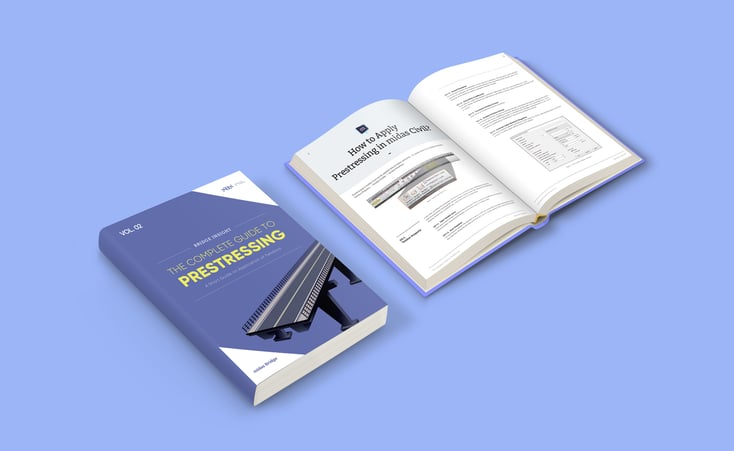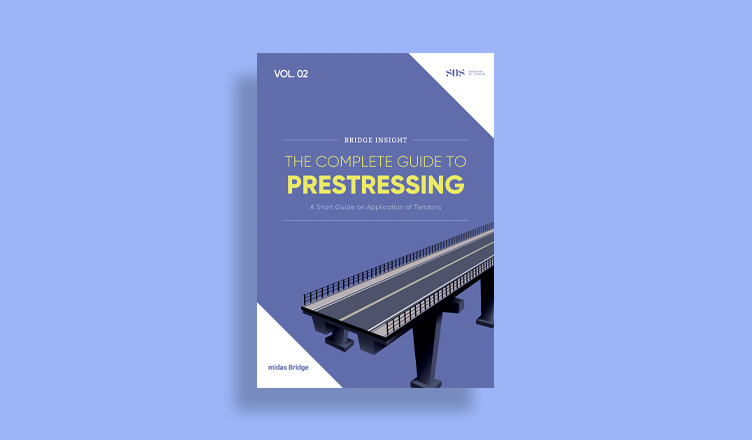Confused about how to model Prestressing?
Please fill out the Download Section (Click here) below the Comment Section to download the PDF Files!
Prestressing concrete provides internal compression, which counteracts the tension caused by loads coming onto it. It can be internal or external, pre-tensioned or post-tensioned, straight or curved. But the important thing is the application of appropriate prestressing load in the proper location along the length of the girder/beam.
Through this eBook, you can understand different tendons, and various profile generation techniques and appropriately predict the various long-term and immediate losses in midas civil. Examples are used for the calculation and verification of the losses in midas civil. Some key tips/notes are provided along the way for better modeling.

Key Points
1. What is prestressing?
Prestressing is the process by which the concrete element is compressed using wires, strands, etc. Concrete is a compression resisting material and its tension resisting capacity is very poor. So, the ultimate purpose of prestressing is that most of the concrete remains in compression even after the load is applied.
This can be achieved via 3 methods:
01-1. Internal Pre-tension
01-2. Internal Post-tension
01-3. External Post-tension
2. Losses in Tendons
They are mainly divided into 2 categories: Immediate loss and long-term loss.
3. How to Apply Prestressing in MIDAS CIVIL?
03-1. Tendon Property
03-1-1. Total Tendon Area
03-1-2. Duct Diameter
03-1-3. Strand Diameter
03-1-4. Relaxation Coefficient
03-1-5. Curvature Friction Factor
03-1-6. Wobble Friction Factor
03-1-7. External Cable Moment Magnifier
03-2. Tendon Property
03-2-1. Typical Tendon
03-2-2. Debonded Length
03-2-3. Reference Axis
03-2-4. Profile Insertion Point
03-2-5. Point of Symmetry
03-2-6. X-axis Direction
03-3. Tendon Prestress
4. Methods of Defining a Tendon Profile
04-1. Simple Beam
04-2. Curved Tendon Profile
04-3. Beam in X-Y Plane
04-4. PSC Section with Inclined Web
04-5. Copying of Tendon
5. Loss Verification
05-1. Immediate Loss
05-1-1. Elastic Shortening Loss
05-1-2. Anchorage Slip
05-1-3. Friction Loss
05-1-4. Creep & Shrinkage Loss
05-1-5. Relaxation Loss
6. Common Mistakes While Modeling Tendons
Common mistakes while modeling the tendon in midas Civil occur while defining the tendon profile.
Please fill out the Download Section (Click here) below the Comment Section to download the PDF Files!
 Get Started midas Civil
Get Started midas Civil
 Featured blog of this week
Featured blog of this week







/2020%20Pics%20for%20drafts/Moving%20Load%20All%20You%20Need%20to%20Know-1.jpeg)
/MC%2004%20Section/How%20to%20Define%20Section%20Properties%20in%20Various%20Bridge%20Design%20Conditions%20345%20240.png)
/345%20240/Application%20of%20Links%20in%20Bridge%20FE%20Models.png)